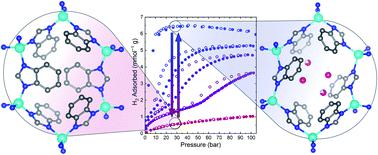当前位置:
X-MOL 学术
›
Chem. Sci.
›
论文详情
Our official English website, www.x-mol.net, welcomes your
feedback! (Note: you will need to create a separate account there.)
Structural resolution and mechanistic insight into hydrogen adsorption in flexible ZIF-7
Chemical Science ( IF 7.6 ) Pub Date : 2021-11-24 , DOI: 10.1039/d1sc04618g Ryan A Klein 1, 2 , Sarah Shulda 1 , Philip A Parilla 1 , Pierre Le Magueres 3 , Rachelle K Richardson 4 , William Morris 4 , Craig M Brown 2, 5 , C Michael McGuirk 6
Chemical Science ( IF 7.6 ) Pub Date : 2021-11-24 , DOI: 10.1039/d1sc04618g Ryan A Klein 1, 2 , Sarah Shulda 1 , Philip A Parilla 1 , Pierre Le Magueres 3 , Rachelle K Richardson 4 , William Morris 4 , Craig M Brown 2, 5 , C Michael McGuirk 6
Affiliation

|
Flexible metal–organic frameworks offer a route towards high useable hydrogen storage capacities with minimal swings in pressure and temperature via step-shaped adsorption and desorption profiles. Yet, the understanding of hydrogen-induced flexibility in candidate storage materials remains incomplete. Here, we investigate the hydrogen storage properties of a quintessential flexible metal–organic framework, ZIF-7. We use high-pressure isothermal hydrogen adsorption measurements to identify the pressure–temperature conditions of the hydrogen-induced structural transition in ZIF-7. The material displays narrow hysteresis and has a shallow adsorption slope between 100 K and 125 K. To gain mechanistic insight into the cause of the phase transition correlating with stepped adsorption and desorption, we conduct powder neutron diffraction measurements of the D2 gas-dosed structures at conditions across the phase change. Rietveld refinements of the powder neutron diffraction patterns yield the structures of activated ZIF-7 and of the gas-dosed material in the dense and open phases. The structure of the activated phase of ZIF-7 is corroborated by the structure of the activated phase of the Cd congener, CdIF-13, which we report here for the first time based on single crystal X-ray diffraction measurements. Subsequent Rietveld refinements of the powder patterns for the gas-dosed structure reveal that the primary D2 adsorption sites in the dense phase form D2–arene interactions between adjacent ligands in a sandwich-like adsorption motif. These sites are prevalent in both the dense and the open structure for ZIF-7, and we hypothesize that they play an important role in templating the structure of the open phase. We discuss the implications of our findings for future approaches to rationally tune step-shaped adsorption in ZIF-7, its congeners, and flexible porous adsorbents in general. Lastly, important to the application of flexible frameworks, we show that pelletization of ZIF-7 produces minimal variation in performance.
中文翻译:

柔性 ZIF-7 中氢吸附的结构分辨率和机理洞察
柔性金属有机框架通过阶梯形吸附和解吸曲线提供了一条实现高可用储氢能力的途径,并且压力和温度波动最小。然而,对候选存储材料中氢引起的灵活性的理解仍然不完整。在这里,我们研究了典型的柔性金属有机框架 ZIF-7 的储氢特性。我们使用高压等温氢吸附测量来确定 ZIF-7 中氢诱导结构转变的压力-温度条件。该材料表现出窄滞后现象,并且在 100 K 至 125 K 之间具有较浅的吸附斜率。为了深入了解与阶梯式吸附和解吸相关的相变原因,我们对 D 2气体剂量结构进行了粉末中子衍射测量在跨越相变的条件下。Rietveld 对粉末中子衍射图谱的改进得到了活化 ZIF-7 以及致密相和疏散相气体掺杂材料的结构。ZIF-7 活化相的结构得到了 Cd 同系物 CdIF-13 活化相结构的证实,这是我们首次基于单晶 X 射线衍射测量报告的。随后 Rietveld 对气体剂量结构的粉末模式进行了改进,揭示了致密相中的主要 D 2吸附位点形成了三明治状吸附基序中相邻配体之间的 D 2 -芳烃相互作用。这些位点在 ZIF-7 的致密结构和开放结构中都很常见,我们假设它们在模板化开放相结构中发挥着重要作用。我们讨论了我们的研究结果对未来合理调整 ZIF-7、其同系物和柔性多孔吸附剂阶梯形吸附的影响。最后,对于灵活框架的应用很重要,我们表明 ZIF-7 的颗粒化产生的性能变化最小。
更新日期:2021-11-24
中文翻译:

柔性 ZIF-7 中氢吸附的结构分辨率和机理洞察
柔性金属有机框架通过阶梯形吸附和解吸曲线提供了一条实现高可用储氢能力的途径,并且压力和温度波动最小。然而,对候选存储材料中氢引起的灵活性的理解仍然不完整。在这里,我们研究了典型的柔性金属有机框架 ZIF-7 的储氢特性。我们使用高压等温氢吸附测量来确定 ZIF-7 中氢诱导结构转变的压力-温度条件。该材料表现出窄滞后现象,并且在 100 K 至 125 K 之间具有较浅的吸附斜率。为了深入了解与阶梯式吸附和解吸相关的相变原因,我们对 D 2气体剂量结构进行了粉末中子衍射测量在跨越相变的条件下。Rietveld 对粉末中子衍射图谱的改进得到了活化 ZIF-7 以及致密相和疏散相气体掺杂材料的结构。ZIF-7 活化相的结构得到了 Cd 同系物 CdIF-13 活化相结构的证实,这是我们首次基于单晶 X 射线衍射测量报告的。随后 Rietveld 对气体剂量结构的粉末模式进行了改进,揭示了致密相中的主要 D 2吸附位点形成了三明治状吸附基序中相邻配体之间的 D 2 -芳烃相互作用。这些位点在 ZIF-7 的致密结构和开放结构中都很常见,我们假设它们在模板化开放相结构中发挥着重要作用。我们讨论了我们的研究结果对未来合理调整 ZIF-7、其同系物和柔性多孔吸附剂阶梯形吸附的影响。最后,对于灵活框架的应用很重要,我们表明 ZIF-7 的颗粒化产生的性能变化最小。











































 京公网安备 11010802027423号
京公网安备 11010802027423号